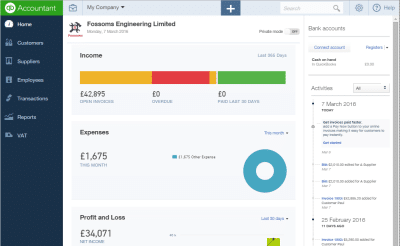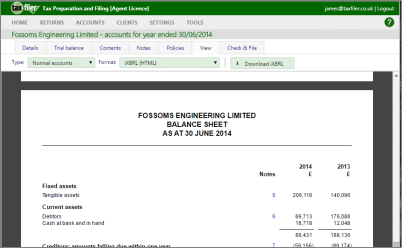Over two thousand accounting firms are already using Taxfiler and enjoying the benefits of the cloud revolution.
Tens of thousands of UK businesses use Intuit QuickBooks Online, the cloud bookkeeping software.
Now Taxfiler and Intuit have partnered to simplify the transfer of client details and trial balance figures straight from QuickBooks into Taxfiler Accounts Preparation.
Read on to see how Taxfiler and QuickBooks can benefit your practice.

Login to your Taxfiler account

If you don’t yet have a Taxfiler account, it only takes a moment to set one up.
Taxfiler delivers all the functions of traditional desktop tax software through powerful cloud servers, ensuring a quality user experience from anywhere.
Prices start at just £10 a month for a full suite of accounts preparation and tax return production software.
Connect Taxfiler to your clients’ QuickBook file

Taxfiler can only access the QuickBooks clients that you authorise by using your QuickBooks Online Accountant login.
Authorisation takes a few seconds, and this will create a new Taxfiler client with all the business details copied from the QuickBooks file. This saves you time and avoids errors.
Once you have connected Taxfiler to the correct QuickBooks client, the connection will be remembered for as long as you need.
Transfer trial balance figures from QuickBooks

Taxfiler and Intuit have worked hard to ensure that the QuickBooks accounts will map to the correct locations in Taxfiler, avoiding the need for tedious manual adjustments.
By understanding the QuickBooks account detail types, Taxfiler is able to make intelligent choices about where figures should appear in the accounts.
And if you do need to make any adjustments, this is quick and easy using the simple editing functions in Taxfiler.
Create and populate the Tax Return

Taxfiler will create the CT600 tax return and copy the figures from the draft accounts. Non-trading income and disallowable items will be identified and entered as adjustments.
Make further amendments to the return as required, specifying capital allowances, allocating losses and calculating any adjustments such as R&D tax credits.
Taxfiler will provide full computations and calculate the tax for the period that can then be included in the final accounts.
Submit accounts to Companies House

Finalise the accounts in preparation for filing. Taxfiler allows notes and disclosures to be entered and reviewed in moments.
Full accounts are created for client approval, including a Directors’ Report. An Accountants Report and Detailed Profit and Loss account can also be selected.
Once finalised and approved by the client, Taxfiler will submit abbreviated accounts to Companies House right from the accounts review page.
Submit Tax Return to HMRC

Make any final adjustments to prepare the Tax Return for filing to HMRC.
Taxfiler attaches the fully-tagged iXBRL accounts to the Tax Return and generates an iXBRL computation. Additional PDF attachments can also be uploaded.
Once the return is finalised an IRmark is generated and the client can approve the final submission.
After submitting the Tax Return to HMRC, the electronic receipt is retrieved and stored in the Taxfiler database.
Post a Journal to QuickBooks

Taxfiler can update QuickBooks to create the necessary tax liability for each relevant accounting period at the click of a button, helping to keep the clients’ books up to date.
Taxfiler and Intuit are currently working to improve the link further by including a full report of journal adjustments made for the final accounts and to automate the posting of all journals to QuickBooks Online.
Get Connected with Taxfiler and Intuit QuickBooks
Scroll down to see prices for Taxfiler and read more about the full set of features available with every subscription.

You can find out more about QuickBooks Online by visiting https://www.quickbooks.co.uk/accounting-software/
These monthly plans are for agents. To file a single tax return for an individual, partnership or trust, see our site for non-accountants. Click here.
Startup
£11
per month
+VAT
10 clients
Single user
Statutory Accounts
Corporation Tax
Self Assessment
- Individuals
- Partnerships
- Trusts & Estates
MTD for VAT
Bookkeeping Integrations
For startup practices
Solo
£24
per month
+VAT
(10% disc if paid annually)
30 clients
Single user
Statutory Accounts
Corporation Tax
Self Assessment
- Individuals
- Partnerships
- Trusts & Estates
MTD for VAT
Bookkeeping Integrations
Deadline Diary
For sole practitioners
Pro
£36
per month
+VAT
(10% disc if paid annually)
Unlimited clients
Multi user (£36 per user / per month)
Statutory Accounts
Corporation Tax
Self Assessment
- Individuals
- Partnerships
- Trusts & Estates
MTD for VAT
Bookkeeping Integrations
Deadline Diary
Single or multi user
Team
£236
per month
+VAT
(10% disc if paid annually)
Unlimited clients
10 users (Additional users £24 per month)
Statutory Accounts
Corporation Tax
Self Assessment
- Individuals
- Partnerships
- Trusts & Estates
MTD for VAT
Bookkeeping Integrations
Deadline Diary
Multi user
Prices quoted exclude VAT. Subscriptions are payable by monthly direct debit or PayPal.
Packed with functionality
Whichever pricing plan you choose, you will have all these features included. This is just one reason why more and more practices are moving to Taxfiler and joining the cloud revolution

Quickly and easily prepare final accounts from trial balance stage, using simple manual entry or importing figures from bookkeeping software. Add notes and disclosures which will be numbered and tagged correctly. Transfer the balances seamlessly from the completed accounts to the tax return, saving time and avoiding errors. Submit iXBRL-tagged abbreviated accounts directly to Companies House at the click of a button. Includes full support for small companies, micro-entities, sole-traders and partnerships. Updated for FRS 102 and FRS 105

Quickly complete the correct forms for any accounting period. Long periods of account can be apportioned automatically across multiple accounting periods.
Generate fully-tagged iXBRL computations, complete with Capital Allowances, Chargeable Gains (including calculation of indexation) and Research & Development tax credits.
Include any required supplementary forms including Participator Loans, Group Relief and Charities. Upload PDF attachments to be submitted with the tax return.
Submit the tax return directly to HMRC using your agent credentials.

Use simple data input screens to prepare the main tax return and all supplementary forms. Transfer trade accounts directly from Taxfiler accounts preparation or import from external software. Use the built-in calculators to help with capital allowances, chargeable gains, averaging etc.
Produce detailed schedules and computations, and upload additional attachments in PDF format.
Review the tax return and prepare it for filing. Once approved by the client the return can be submitted directly to HMRC using your agent credentials, and the submission receipt will be stored as proof of filing.

Enter details of partnership income using our straight-forward data input screens. Transfer the profit and loss account and balance sheet directly from Taxfiler accounts preparation, or import from external bookkeeping software.
Allocating profits to partners is simple, and you can link to each partner’s individual record so the data is seamlessly updated to their own personal tax return.
The partnership tax return can be submitted directly to HMRC using your agent credentials, and the submission receipt will be stored as proof of filing.

Select from a variety of trust types including charitable and non-resident trusts. Entering details of trust income and allowable expenditure is quick and easy, and you can also input details of beneficiaries and any discretionary payments made.
Taxfiler will calculate the tax payable by the trust, including any tax due on discretionary payments, and will also perform the necessary tax pool calculations.
The tax return can be submitted directly to HMRC using your agent credentials, and the submission receipt will be stored as proof of filing.
Taxfiler will also generate R185 forms containing the details of trust payments, and these can be distributed to beneficiaries as required.
